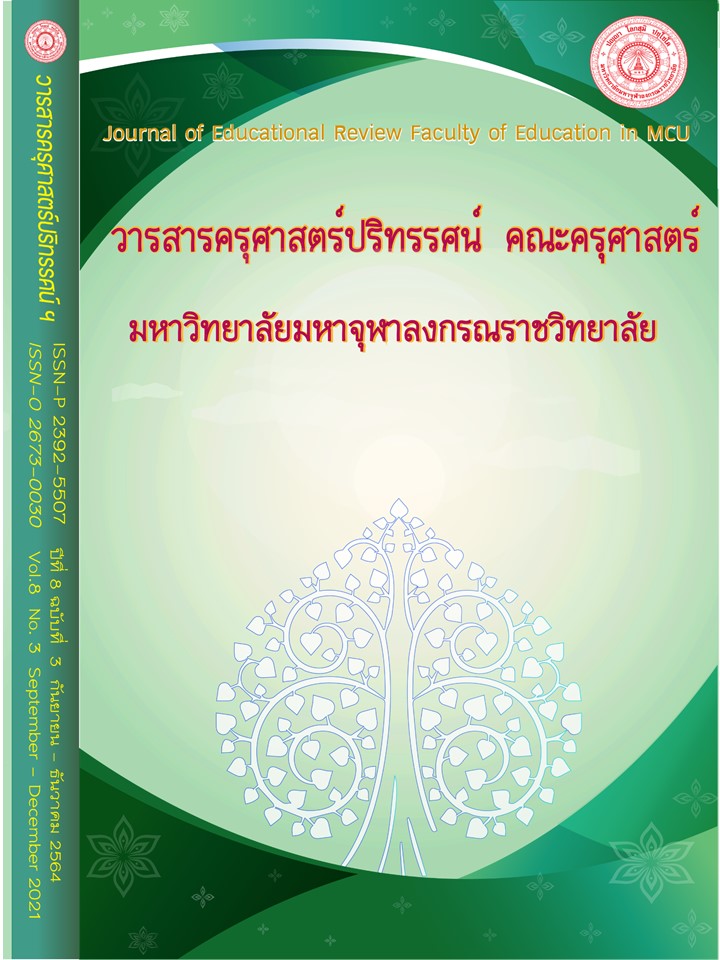A MODEL FOR LEARNING MANAGEMENT ON THERAVADA BUDDHIST TEMPLE SCULPTURES IN BANGKOK
Main Article Content
Abstract
This research article aimed to propose a model for learning management of Theravada Buddhist sculptures of temples in Bangkok. It is a qualitative research consisting of documentary research and Interviews with 15 key informants and focus group discussion with 10 experts. Data were analyzed by content analysis. Results of the research found that a model for learning management of Theravada Buddhist sculptures of temples in Bangkok was a process of learning to reach the principles of Buddhism and learning about art history that are linked to religion enabling learners to learn happily. There were 5 components: Part 1 Principles, Part 2 Objectives consisted of 1) to develop learning sculptures to become knowledge, skills, and analytical and practical attitudes of learners, 2) to set goals and objectives; Part 3 Model Management Process which were 1) Learning Subject, 2) Learning Cognitive Activities and learning sources, 3) Integration of Buddhist principles, and 4) decision-making process; Part 4: Applying the model consisted of 1)should understand the implementation process, 2) should create a learning package, 3) the developer must able to allocate development time, 4) learning management of Buddhist sculptures, and part 5 evaluation which were 1) model evaluation stage, and 2) model improvement stage.
Article Details
ทัศนะและความคิดเห็นที่ปรากฏในบทความในวารสารฉบับนี้ถือเป็นความรับผิดชอบของผู้เขียนบทความนั้นเพียงผู้เดียว และไม่ถือเป็นทัศนะและความรับผิดชอบของกองบรรณาธิการ
กองบรรณาธิการขอสงวนสิทธิ์ในการคัดเลือกบทความลงตีพิมพ์และจะแจ้งให้เจ้าของบทความทราบหลังจากผู้ประเมินบทความตรวจอ่านบทความแล้ว
ต้นฉบับที่ได้รับการตีพิมพ์ในวารสารครุศาสตร์ปริทรรศน์ คณะครุศาสตร์ มหาวิทยาลัยมหาจุฬาลงกรณราชวิทยาลัย ถือเป็นกรรมสิทธิ์ของคณะครุศาสตร์ มหาวิทยาลัยมหาจุฬาลงกรณราชวิทยาลัย ห้ามนำข้อความทั้งหมดหรือบางส่วนไปพิมพ์ซ้ำ เว้นเสียแต่ว่าจะได้รับอนุญาตจากมหาวิทยาลัยฯ เป็นลายลักษณ์อักษร
References
กรมศิลปากร. (2545). พระพุทธรูปสำคัญ. กรุงเทพมหานคร: กรมศิลปากร.
กุลชาดา โตโภชนพันธุ์, มยุรี ขวบสันเทียะ และสุทธิยา ปิ่นมณี. (2551). การสร้างแหล่งเรียนรู้บนเครือข่ายอินเทอร์เน็ต: การหล่อพระ จังหวัดพิษณุโลก. วิทยานิพนธ์ศึกษาศาสตรมหาบัณฑิต. มหาวิทยาลัยนเรศวร.
ชวนคิด มะเสนะ. (2554). รูปแบบการจัดการศึกษาปฐมวัยที่สอดคล้องกับการพัฒนาสมอง. ดุษฎีนิพนธ์ครุศาสตรดุษฎีบัณฑิต. มหาวิทยาลัยราชภัฏอุบลราชธานี.
โชติ กัลยาณมิตร. (2539). สถาปัตยกรรมแบบไทยเดิม. กรุงเทพมหานคร: มหาวิทยาลัยธรรมศาสตร์.
ปราโมทย์ เบญจกาญจน์ และคณะ. (2548). รูปแบบการพัฒนาพฤติกรรมภาวะผู้นำทางวิชาการของผู้บริหารสถานศึกษาขั้นพื้นฐาน. รายงานวิจัย. กระทรวงศึกษาธิการ.
สมชาย วรกิจเกษมสกุล. (2553). ระเบียบวิธีการวิจัยทางพฤติกรรมศาสตร์และสังคมศาสตร์. อุดรธานี: คณะครุศาสตร์ มหาวิทยาลัยราชภัฏอุดรธานี.
สุเชษฐ์ สมิตินันทน์. (2517). พุทธศิลป์ในประเทศไทย. วารสารรามคำแหง. 1(1). 102-105.


